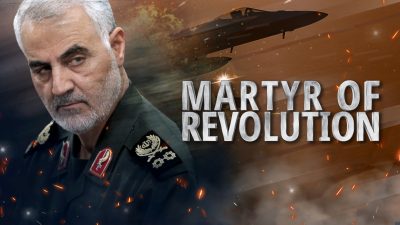By South
Front
Global Research, January 07,
2020
South Front 6 January 2020
Region: Middle East & North Africa
Theme: US NATO War Agenda
In-depth
Report: IRAN: THE NEXT WAR?

For the first time in the
history of Iran, a red flag was raised over the Holy Dome of Jamkaran Mosque in
the holy city of Qom both symbolizing blood spilled unjustly and serving as a
call to avenge a person who is killed. “Those who want to avenge the blood of
Hussein,” read the words of the war flag. This was done in honor of General
Qassem Suleimani, who, along with several other Iranian and Iraqi
commanders, was assassinated in US strikes on Baghdad. The red flag was not
even raised during the Iran-Iraq war (September 22, 1980 – August 20, 1988),
the longest and bloodiest conflict in the history of modern Iran, known in it
as the Holy Defense.
The raised flag demonstrates
both the Iranian resolve to respond to the act of state terrorism committed by
the United States and the significance of the personality of Soleimani for the
state and nation. The general, once described by Supreme Leader Ayatollah Ali
Khamenei as a “living martyr of the revolution”, was the most effective
battlefield commander of the modern world and one of the key people behind the
defeat of ISIS in Syria and Iraq. In March 2019, Soleimani was awarded the
Order of Zulfaqar, Iran’s highest military order.
During his life Suleimani
was a living legend overseeing operations abroad, achieving key military
diplomatic victories and spreading Tehran’s influence around the Middle East.
After his death he has become an icon of the resistance both in Iran and in a large
part of the Arab world. His assassination drastically increased the likelihood
of an open military conflict between the US and Iran, a conflict which could
easily set the entire region on fire.
Born to an impoverished
family in 1957, Soleimani joined the Islamic Revolutionary Guard Corps (IRGC)
after the Iranian revolution in 1979. He rose to prominence commanding troops
during the Iran-Iraq War. After the war, Soleimani largely disappeared from
public view until 2011, when he took over the IRGC’s expeditionary Qods Force
and was promoted to Major General by Supreme Leader Ayatollah Ali Khamenei.
Trump’s Mass Deception on Iran
Over the course of his
career, he developed close ties with Kurdish groups in Iraq, assisted Hezbollah
in Lebanon and led Iranian military operations assisting Syrian and Iraqi
troops in battles against terrorists, primarily ISIS. Soleimani was frequently
pictured on key frontlines from Iraq’s Mosul to Syria’s Aleppo. For example, in
2014, he helped to forge the defense of Baghdad against encroaching ISIS
terrorists. In 2015 he assisted the Iraqi government in operations to
retake the oil-rich city of Tikrit from ISIS. In 2017 the General took personal
command of the battle against ISIS in Syria’s Bukamal. The success of the
Syrian-Iranian-Russian coalition in the Syrian war can to a great extent be
attributed to actions of the Qods Force leader and the Russian military power
backing him. In Yemen, Soleimani’s Qods Force successfully helped local
resistance forces to break the plans of the invading coalition led by Saudi
Arabia. Thus, Ansar Allah (also known as the Houthis) kept Yemen’s capital in
their hands, spread the war onto the territory of Saudi Arabia and de-facto
achieved a military victory in a conflict with a numerically superior and
technologically advanced enemy. Iranian media repeatedly reported on
assassination plots against the commander by the US, Israel and Saudi Arabia.
The outcome of the conflicts in Syria, Iraq and Yemen undermined the positions
of these powers in the region, thus creating a vacuum which Iran proceeded to
fill.
The role of Soleimani for
the Iranian nation can be compared to that of Soviet ‘Marshal of Victory’
Georgy Zhukov in 1945, taking into account the difference in scale of the wars
and victories, as well as the different geography and historical period.
Soleimani’s popularity was such that there was speculation that he might run
for president. In 2016, a poll showed that 76% of Iranians held a favorable
view of him, with more than half reporting a “very favorable” opinion. He
denied the rumors, saying he hoped to remain a soldier until the end of his
life.
Supreme Leader Ayatollah Ali
Khamenei called for three days of mourning, saying Soleimani’s death will
double the motivation of the resistance against the US and Israel. Khamenei
emphasized that harsh revenge awaits the “criminals” who killed Soleimani. Hundreds
of thousands of people rallied in Iraq and Iran mourning his death and
condemning the US aggression, which is viewed by many as a declaration of war.
*
Note to readers: please
click the share buttons above or below. Forward this article to your email
lists. Crosspost on your blog site, internet forums. etc.
Support South Front in its
endeavors. If you’re able, and if you like our content and approach,
please support the project. Our work wouldn’t be possible without your
help: PayPal: southfront@list.ru or via: http://southfront.org/donate/ or via: https://www.patreon.com/southfront
The original source of this
article is South Front
Copyright © South
Front, South Front, 2020






No comments:
Post a Comment